Understanding Hegemonic Masculinity and its Contribution
VerifiedAdded on 2023/01/07
|11
|3602
|59
AI Summary
This essay explores the concept of hegemonic masculinity and its contribution in understanding gender roles and power dynamics within society. It discusses the dominance of males over females and the weaker section of society, as well as the pros and cons of this concept. The essay also highlights the need for promoting equality and eradicating hegemonic masculinity in order to create a better working environment.
Contribute Materials
Your contribution can guide someone’s learning journey. Share your
documents today.

PROJECT- 2 PARTS
Secure Best Marks with AI Grader
Need help grading? Try our AI Grader for instant feedback on your assignments.
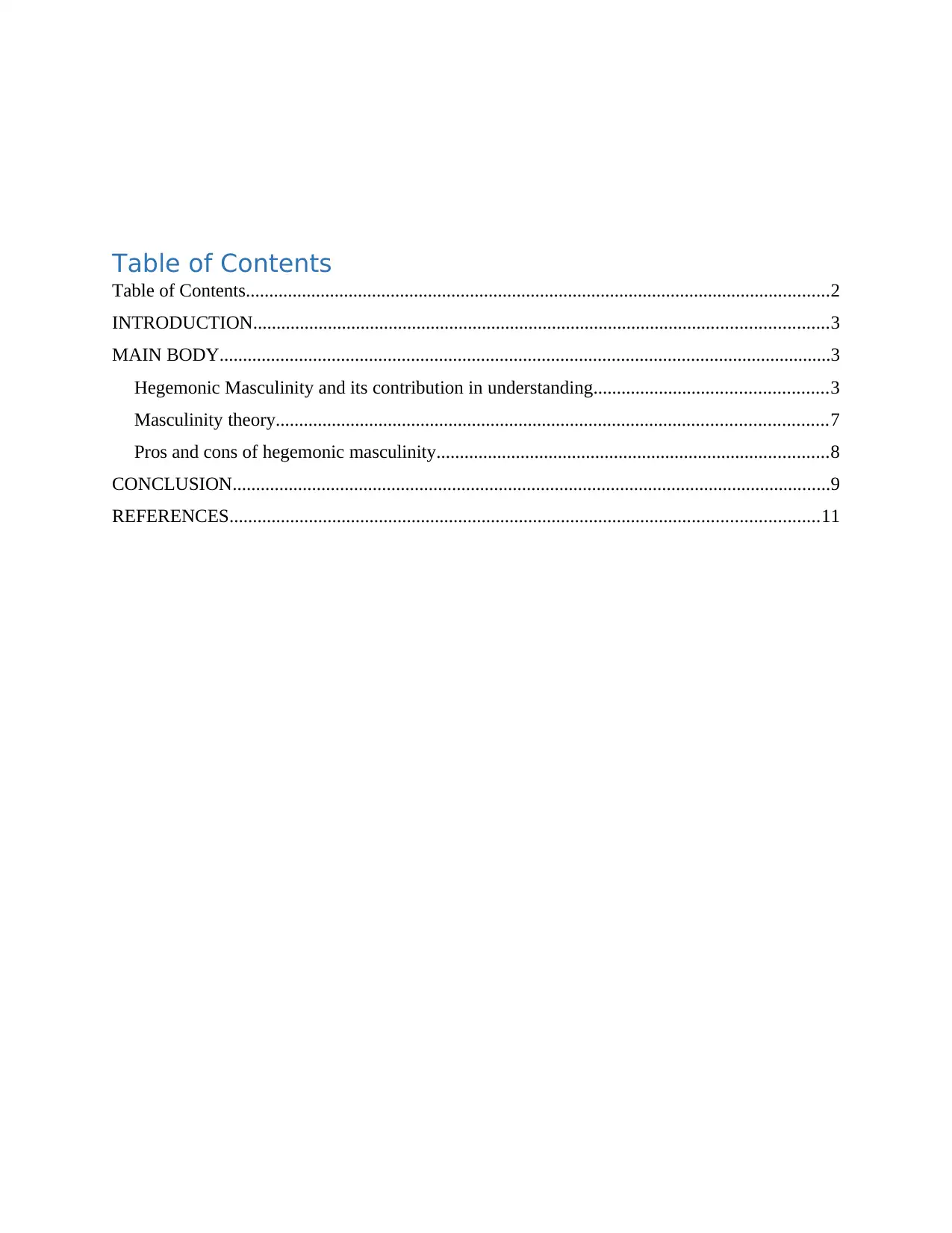
Table of Contents
Table of Contents.............................................................................................................................2
INTRODUCTION...........................................................................................................................3
MAIN BODY...................................................................................................................................3
Hegemonic Masculinity and its contribution in understanding..................................................3
Masculinity theory......................................................................................................................7
Pros and cons of hegemonic masculinity....................................................................................8
CONCLUSION................................................................................................................................9
REFERENCES..............................................................................................................................11
Table of Contents.............................................................................................................................2
INTRODUCTION...........................................................................................................................3
MAIN BODY...................................................................................................................................3
Hegemonic Masculinity and its contribution in understanding..................................................3
Masculinity theory......................................................................................................................7
Pros and cons of hegemonic masculinity....................................................................................8
CONCLUSION................................................................................................................................9
REFERENCES..............................................................................................................................11
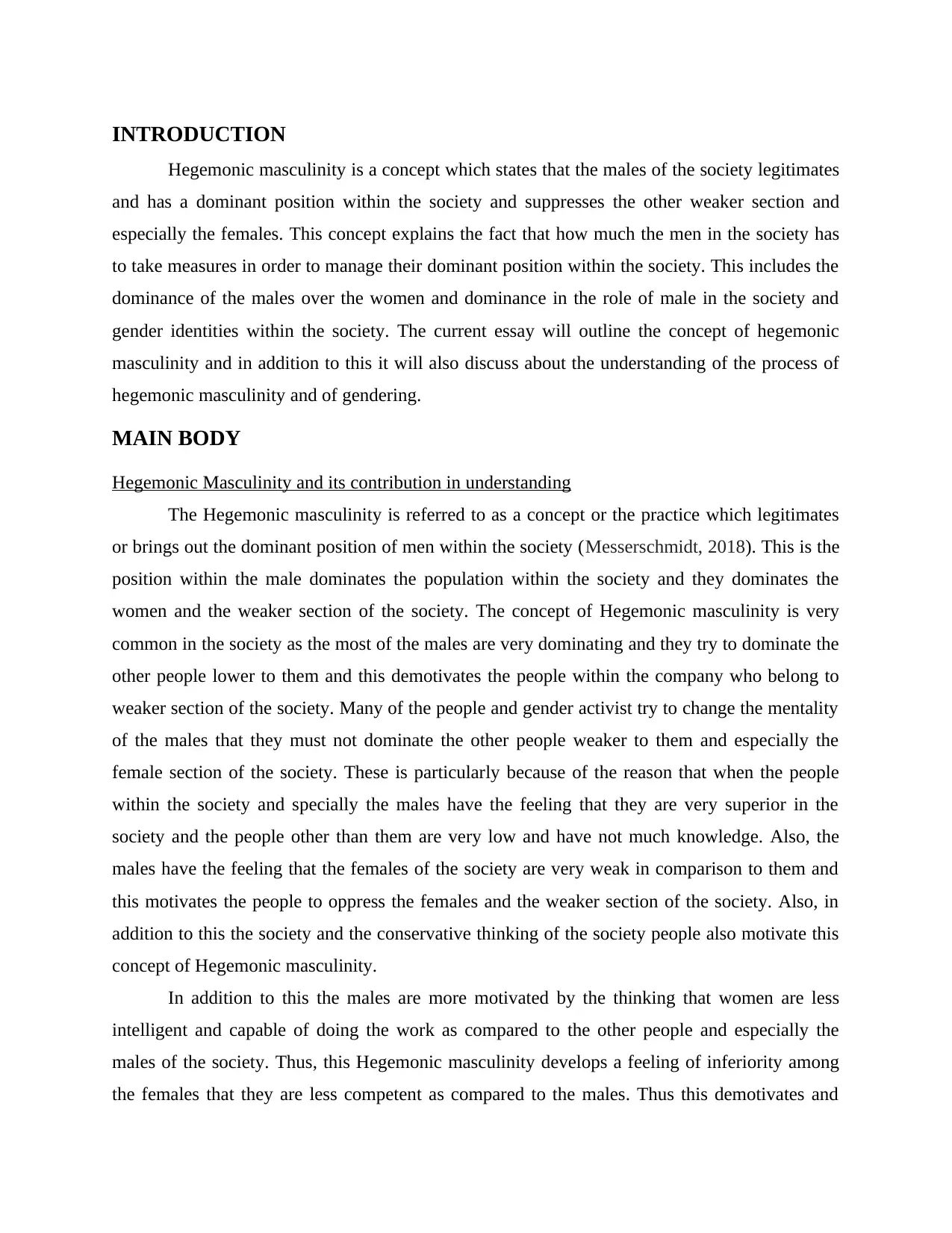
INTRODUCTION
Hegemonic masculinity is a concept which states that the males of the society legitimates
and has a dominant position within the society and suppresses the other weaker section and
especially the females. This concept explains the fact that how much the men in the society has
to take measures in order to manage their dominant position within the society. This includes the
dominance of the males over the women and dominance in the role of male in the society and
gender identities within the society. The current essay will outline the concept of hegemonic
masculinity and in addition to this it will also discuss about the understanding of the process of
hegemonic masculinity and of gendering.
MAIN BODY
Hegemonic Masculinity and its contribution in understanding
The Hegemonic masculinity is referred to as a concept or the practice which legitimates
or brings out the dominant position of men within the society (Messerschmidt, 2018). This is the
position within the male dominates the population within the society and they dominates the
women and the weaker section of the society. The concept of Hegemonic masculinity is very
common in the society as the most of the males are very dominating and they try to dominate the
other people lower to them and this demotivates the people within the company who belong to
weaker section of the society. Many of the people and gender activist try to change the mentality
of the males that they must not dominate the other people weaker to them and especially the
female section of the society. These is particularly because of the reason that when the people
within the society and specially the males have the feeling that they are very superior in the
society and the people other than them are very low and have not much knowledge. Also, the
males have the feeling that the females of the society are very weak in comparison to them and
this motivates the people to oppress the females and the weaker section of the society. Also, in
addition to this the society and the conservative thinking of the society people also motivate this
concept of Hegemonic masculinity.
In addition to this the males are more motivated by the thinking that women are less
intelligent and capable of doing the work as compared to the other people and especially the
males of the society. Thus, this Hegemonic masculinity develops a feeling of inferiority among
the females that they are less competent as compared to the males. Thus this demotivates and
Hegemonic masculinity is a concept which states that the males of the society legitimates
and has a dominant position within the society and suppresses the other weaker section and
especially the females. This concept explains the fact that how much the men in the society has
to take measures in order to manage their dominant position within the society. This includes the
dominance of the males over the women and dominance in the role of male in the society and
gender identities within the society. The current essay will outline the concept of hegemonic
masculinity and in addition to this it will also discuss about the understanding of the process of
hegemonic masculinity and of gendering.
MAIN BODY
Hegemonic Masculinity and its contribution in understanding
The Hegemonic masculinity is referred to as a concept or the practice which legitimates
or brings out the dominant position of men within the society (Messerschmidt, 2018). This is the
position within the male dominates the population within the society and they dominates the
women and the weaker section of the society. The concept of Hegemonic masculinity is very
common in the society as the most of the males are very dominating and they try to dominate the
other people lower to them and this demotivates the people within the company who belong to
weaker section of the society. Many of the people and gender activist try to change the mentality
of the males that they must not dominate the other people weaker to them and especially the
female section of the society. These is particularly because of the reason that when the people
within the society and specially the males have the feeling that they are very superior in the
society and the people other than them are very low and have not much knowledge. Also, the
males have the feeling that the females of the society are very weak in comparison to them and
this motivates the people to oppress the females and the weaker section of the society. Also, in
addition to this the society and the conservative thinking of the society people also motivate this
concept of Hegemonic masculinity.
In addition to this the males are more motivated by the thinking that women are less
intelligent and capable of doing the work as compared to the other people and especially the
males of the society. Thus, this Hegemonic masculinity develops a feeling of inferiority among
the females that they are less competent as compared to the males. Thus this demotivates and
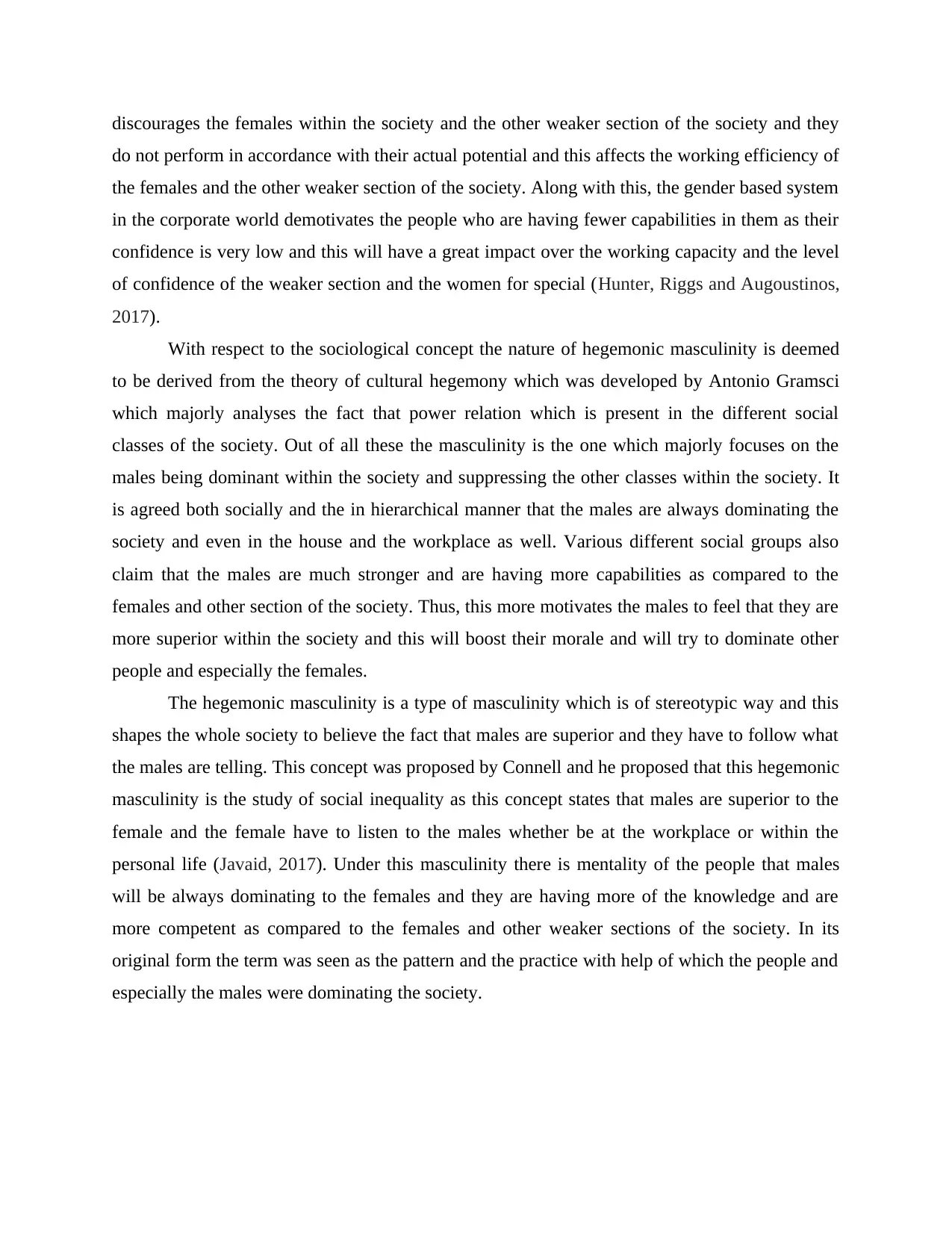
discourages the females within the society and the other weaker section of the society and they
do not perform in accordance with their actual potential and this affects the working efficiency of
the females and the other weaker section of the society. Along with this, the gender based system
in the corporate world demotivates the people who are having fewer capabilities in them as their
confidence is very low and this will have a great impact over the working capacity and the level
of confidence of the weaker section and the women for special (Hunter, Riggs and Augoustinos,
2017).
With respect to the sociological concept the nature of hegemonic masculinity is deemed
to be derived from the theory of cultural hegemony which was developed by Antonio Gramsci
which majorly analyses the fact that power relation which is present in the different social
classes of the society. Out of all these the masculinity is the one which majorly focuses on the
males being dominant within the society and suppressing the other classes within the society. It
is agreed both socially and the in hierarchical manner that the males are always dominating the
society and even in the house and the workplace as well. Various different social groups also
claim that the males are much stronger and are having more capabilities as compared to the
females and other section of the society. Thus, this more motivates the males to feel that they are
more superior within the society and this will boost their morale and will try to dominate other
people and especially the females.
The hegemonic masculinity is a type of masculinity which is of stereotypic way and this
shapes the whole society to believe the fact that males are superior and they have to follow what
the males are telling. This concept was proposed by Connell and he proposed that this hegemonic
masculinity is the study of social inequality as this concept states that males are superior to the
female and the female have to listen to the males whether be at the workplace or within the
personal life (Javaid, 2017). Under this masculinity there is mentality of the people that males
will be always dominating to the females and they are having more of the knowledge and are
more competent as compared to the females and other weaker sections of the society. In its
original form the term was seen as the pattern and the practice with help of which the people and
especially the males were dominating the society.
do not perform in accordance with their actual potential and this affects the working efficiency of
the females and the other weaker section of the society. Along with this, the gender based system
in the corporate world demotivates the people who are having fewer capabilities in them as their
confidence is very low and this will have a great impact over the working capacity and the level
of confidence of the weaker section and the women for special (Hunter, Riggs and Augoustinos,
2017).
With respect to the sociological concept the nature of hegemonic masculinity is deemed
to be derived from the theory of cultural hegemony which was developed by Antonio Gramsci
which majorly analyses the fact that power relation which is present in the different social
classes of the society. Out of all these the masculinity is the one which majorly focuses on the
males being dominant within the society and suppressing the other classes within the society. It
is agreed both socially and the in hierarchical manner that the males are always dominating the
society and even in the house and the workplace as well. Various different social groups also
claim that the males are much stronger and are having more capabilities as compared to the
females and other section of the society. Thus, this more motivates the males to feel that they are
more superior within the society and this will boost their morale and will try to dominate other
people and especially the females.
The hegemonic masculinity is a type of masculinity which is of stereotypic way and this
shapes the whole society to believe the fact that males are superior and they have to follow what
the males are telling. This concept was proposed by Connell and he proposed that this hegemonic
masculinity is the study of social inequality as this concept states that males are superior to the
female and the female have to listen to the males whether be at the workplace or within the
personal life (Javaid, 2017). Under this masculinity there is mentality of the people that males
will be always dominating to the females and they are having more of the knowledge and are
more competent as compared to the females and other weaker sections of the society. In its
original form the term was seen as the pattern and the practice with help of which the people and
especially the males were dominating the society.
Secure Best Marks with AI Grader
Need help grading? Try our AI Grader for instant feedback on your assignments.
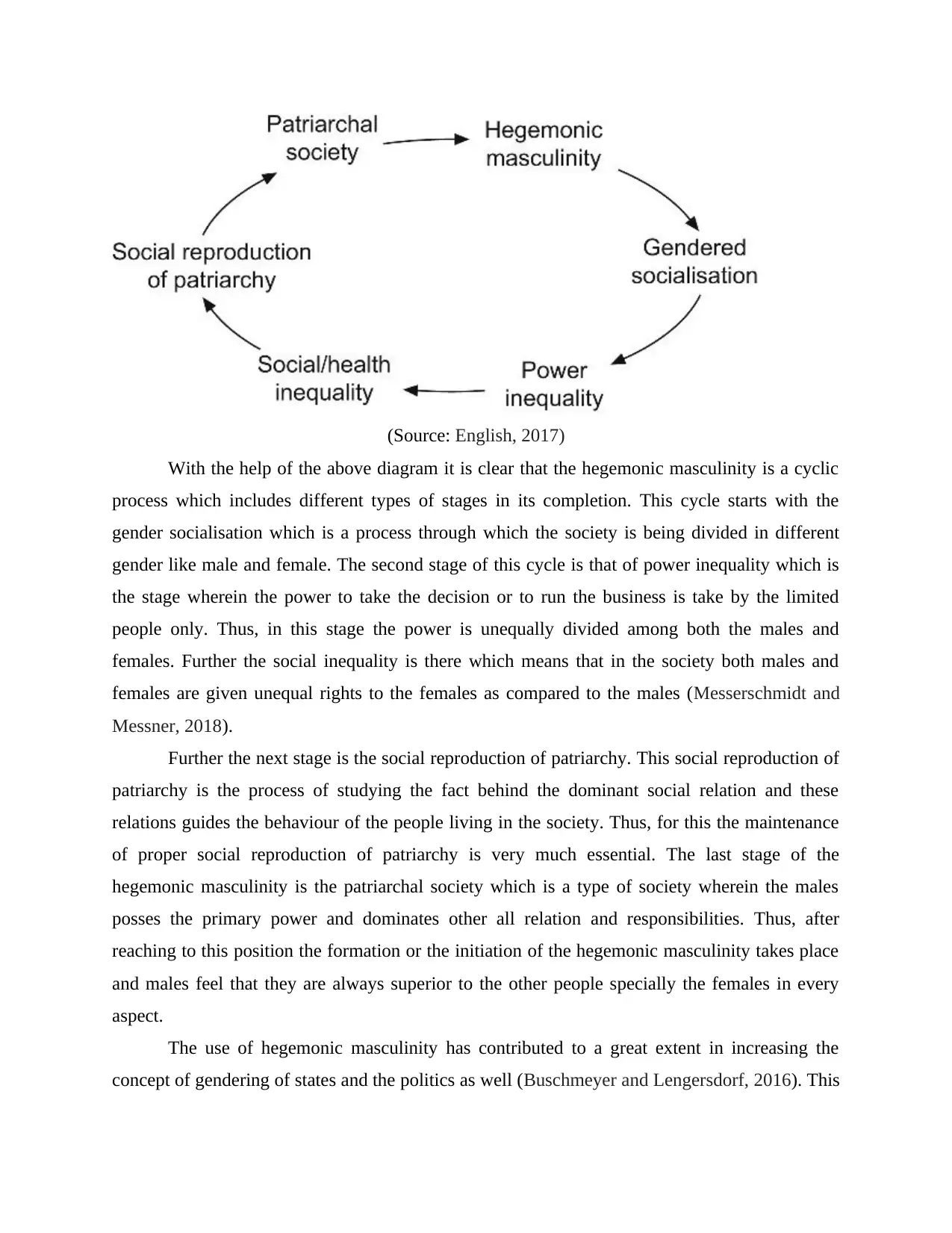
(Source: English, 2017)
With the help of the above diagram it is clear that the hegemonic masculinity is a cyclic
process which includes different types of stages in its completion. This cycle starts with the
gender socialisation which is a process through which the society is being divided in different
gender like male and female. The second stage of this cycle is that of power inequality which is
the stage wherein the power to take the decision or to run the business is take by the limited
people only. Thus, in this stage the power is unequally divided among both the males and
females. Further the social inequality is there which means that in the society both males and
females are given unequal rights to the females as compared to the males (Messerschmidt and
Messner, 2018).
Further the next stage is the social reproduction of patriarchy. This social reproduction of
patriarchy is the process of studying the fact behind the dominant social relation and these
relations guides the behaviour of the people living in the society. Thus, for this the maintenance
of proper social reproduction of patriarchy is very much essential. The last stage of the
hegemonic masculinity is the patriarchal society which is a type of society wherein the males
posses the primary power and dominates other all relation and responsibilities. Thus, after
reaching to this position the formation or the initiation of the hegemonic masculinity takes place
and males feel that they are always superior to the other people specially the females in every
aspect.
The use of hegemonic masculinity has contributed to a great extent in increasing the
concept of gendering of states and the politics as well (Buschmeyer and Lengersdorf, 2016). This
With the help of the above diagram it is clear that the hegemonic masculinity is a cyclic
process which includes different types of stages in its completion. This cycle starts with the
gender socialisation which is a process through which the society is being divided in different
gender like male and female. The second stage of this cycle is that of power inequality which is
the stage wherein the power to take the decision or to run the business is take by the limited
people only. Thus, in this stage the power is unequally divided among both the males and
females. Further the social inequality is there which means that in the society both males and
females are given unequal rights to the females as compared to the males (Messerschmidt and
Messner, 2018).
Further the next stage is the social reproduction of patriarchy. This social reproduction of
patriarchy is the process of studying the fact behind the dominant social relation and these
relations guides the behaviour of the people living in the society. Thus, for this the maintenance
of proper social reproduction of patriarchy is very much essential. The last stage of the
hegemonic masculinity is the patriarchal society which is a type of society wherein the males
posses the primary power and dominates other all relation and responsibilities. Thus, after
reaching to this position the formation or the initiation of the hegemonic masculinity takes place
and males feel that they are always superior to the other people specially the females in every
aspect.
The use of hegemonic masculinity has contributed to a great extent in increasing the
concept of gendering of states and the politics as well (Buschmeyer and Lengersdorf, 2016). This
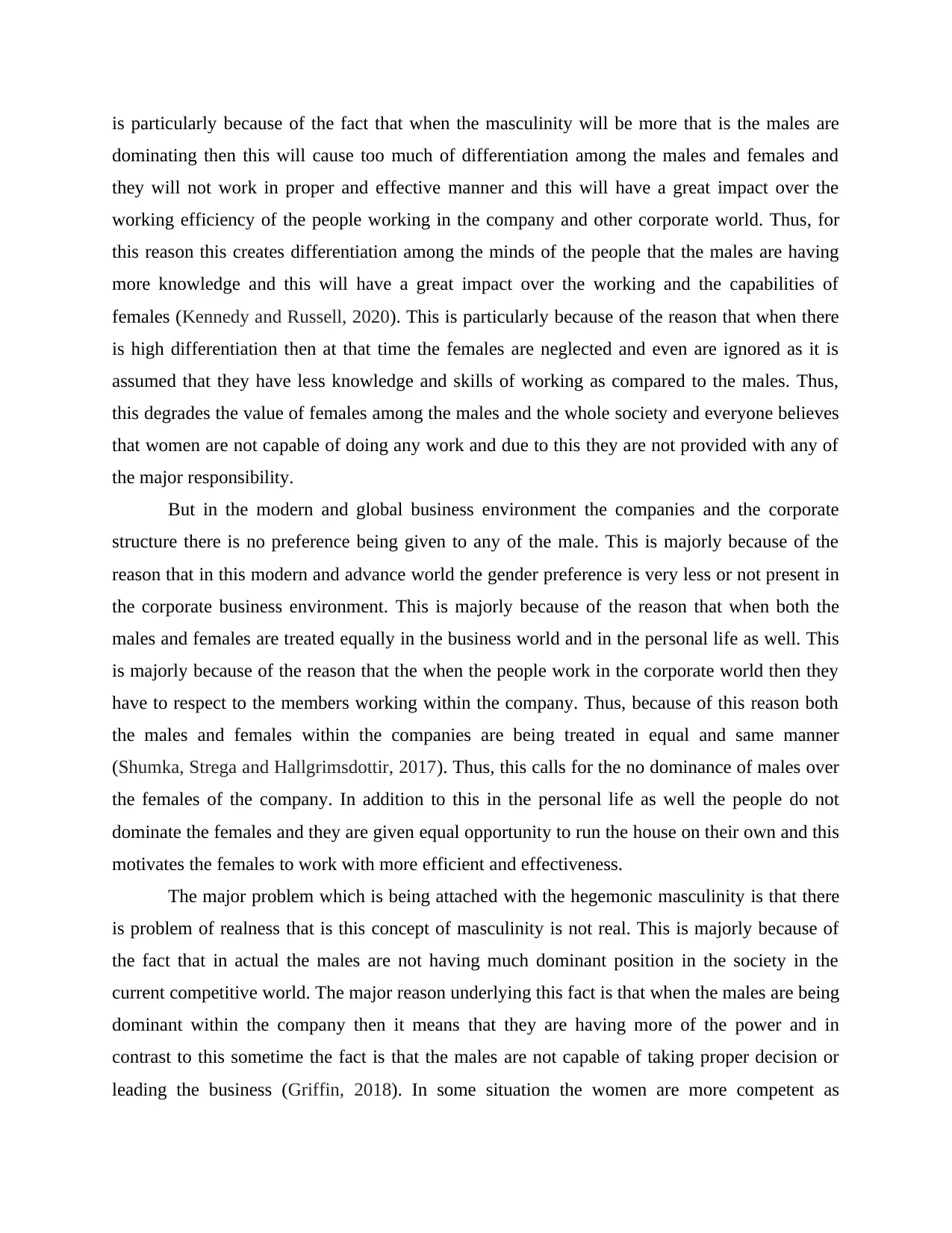
is particularly because of the fact that when the masculinity will be more that is the males are
dominating then this will cause too much of differentiation among the males and females and
they will not work in proper and effective manner and this will have a great impact over the
working efficiency of the people working in the company and other corporate world. Thus, for
this reason this creates differentiation among the minds of the people that the males are having
more knowledge and this will have a great impact over the working and the capabilities of
females (Kennedy and Russell, 2020). This is particularly because of the reason that when there
is high differentiation then at that time the females are neglected and even are ignored as it is
assumed that they have less knowledge and skills of working as compared to the males. Thus,
this degrades the value of females among the males and the whole society and everyone believes
that women are not capable of doing any work and due to this they are not provided with any of
the major responsibility.
But in the modern and global business environment the companies and the corporate
structure there is no preference being given to any of the male. This is majorly because of the
reason that in this modern and advance world the gender preference is very less or not present in
the corporate business environment. This is majorly because of the reason that when both the
males and females are treated equally in the business world and in the personal life as well. This
is majorly because of the reason that the when the people work in the corporate world then they
have to respect to the members working within the company. Thus, because of this reason both
the males and females within the companies are being treated in equal and same manner
(Shumka, Strega and Hallgrimsdottir, 2017). Thus, this calls for the no dominance of males over
the females of the company. In addition to this in the personal life as well the people do not
dominate the females and they are given equal opportunity to run the house on their own and this
motivates the females to work with more efficient and effectiveness.
The major problem which is being attached with the hegemonic masculinity is that there
is problem of realness that is this concept of masculinity is not real. This is majorly because of
the fact that in actual the males are not having much dominant position in the society in the
current competitive world. The major reason underlying this fact is that when the males are being
dominant within the company then it means that they are having more of the power and in
contrast to this sometime the fact is that the males are not capable of taking proper decision or
leading the business (Griffin, 2018). In some situation the women are more competent as
dominating then this will cause too much of differentiation among the males and females and
they will not work in proper and effective manner and this will have a great impact over the
working efficiency of the people working in the company and other corporate world. Thus, for
this reason this creates differentiation among the minds of the people that the males are having
more knowledge and this will have a great impact over the working and the capabilities of
females (Kennedy and Russell, 2020). This is particularly because of the reason that when there
is high differentiation then at that time the females are neglected and even are ignored as it is
assumed that they have less knowledge and skills of working as compared to the males. Thus,
this degrades the value of females among the males and the whole society and everyone believes
that women are not capable of doing any work and due to this they are not provided with any of
the major responsibility.
But in the modern and global business environment the companies and the corporate
structure there is no preference being given to any of the male. This is majorly because of the
reason that in this modern and advance world the gender preference is very less or not present in
the corporate business environment. This is majorly because of the reason that when both the
males and females are treated equally in the business world and in the personal life as well. This
is majorly because of the reason that the when the people work in the corporate world then they
have to respect to the members working within the company. Thus, because of this reason both
the males and females within the companies are being treated in equal and same manner
(Shumka, Strega and Hallgrimsdottir, 2017). Thus, this calls for the no dominance of males over
the females of the company. In addition to this in the personal life as well the people do not
dominate the females and they are given equal opportunity to run the house on their own and this
motivates the females to work with more efficient and effectiveness.
The major problem which is being attached with the hegemonic masculinity is that there
is problem of realness that is this concept of masculinity is not real. This is majorly because of
the fact that in actual the males are not having much dominant position in the society in the
current competitive world. The major reason underlying this fact is that when the males are being
dominant within the company then it means that they are having more of the power and in
contrast to this sometime the fact is that the males are not capable of taking proper decision or
leading the business (Griffin, 2018). In some situation the women are more competent as
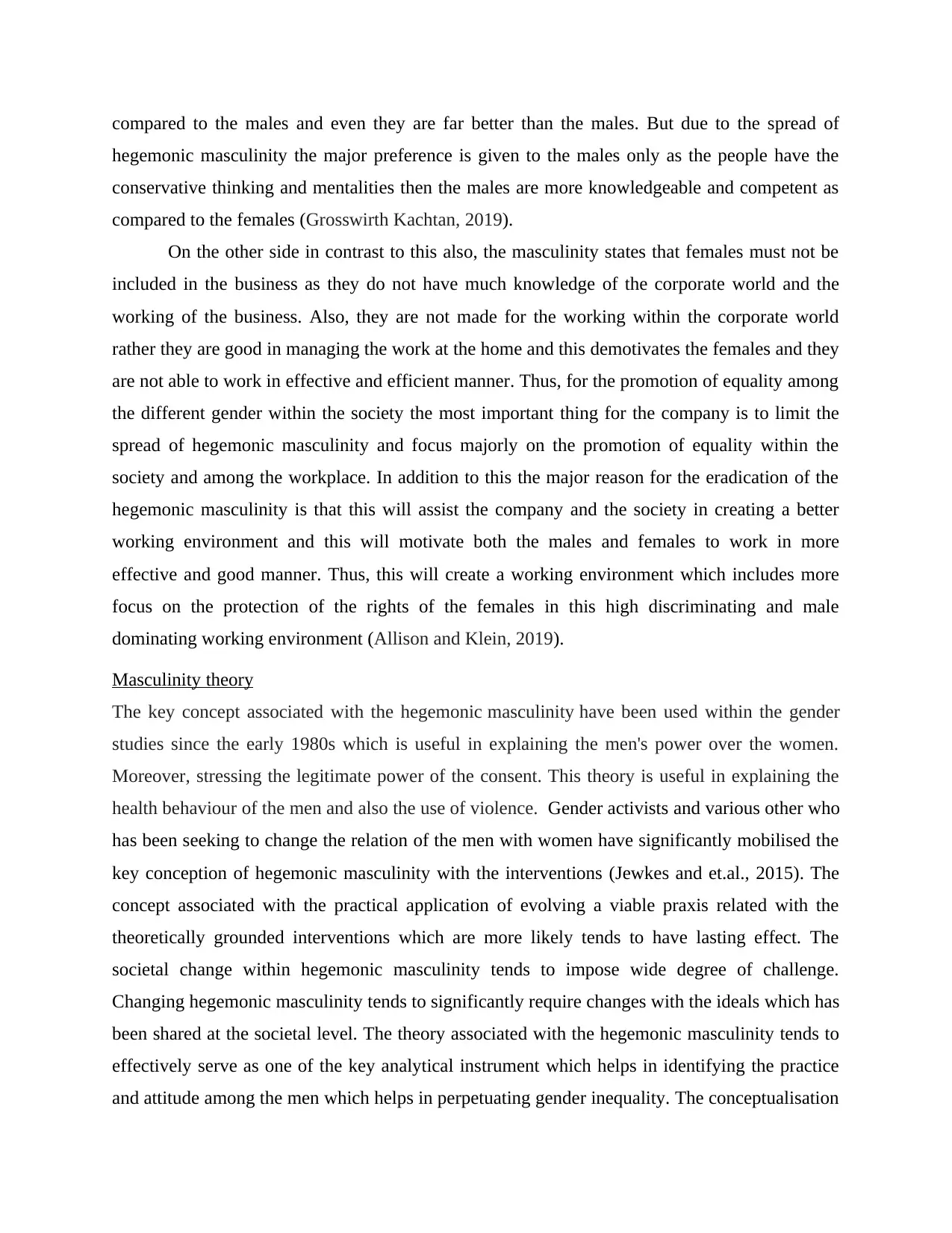
compared to the males and even they are far better than the males. But due to the spread of
hegemonic masculinity the major preference is given to the males only as the people have the
conservative thinking and mentalities then the males are more knowledgeable and competent as
compared to the females (Grosswirth Kachtan, 2019).
On the other side in contrast to this also, the masculinity states that females must not be
included in the business as they do not have much knowledge of the corporate world and the
working of the business. Also, they are not made for the working within the corporate world
rather they are good in managing the work at the home and this demotivates the females and they
are not able to work in effective and efficient manner. Thus, for the promotion of equality among
the different gender within the society the most important thing for the company is to limit the
spread of hegemonic masculinity and focus majorly on the promotion of equality within the
society and among the workplace. In addition to this the major reason for the eradication of the
hegemonic masculinity is that this will assist the company and the society in creating a better
working environment and this will motivate both the males and females to work in more
effective and good manner. Thus, this will create a working environment which includes more
focus on the protection of the rights of the females in this high discriminating and male
dominating working environment (Allison and Klein, 2019).
Masculinity theory
The key concept associated with the hegemonic masculinity have been used within the gender
studies since the early 1980s which is useful in explaining the men's power over the women.
Moreover, stressing the legitimate power of the consent. This theory is useful in explaining the
health behaviour of the men and also the use of violence. Gender activists and various other who
has been seeking to change the relation of the men with women have significantly mobilised the
key conception of hegemonic masculinity with the interventions (Jewkes and et.al., 2015). The
concept associated with the practical application of evolving a viable praxis related with the
theoretically grounded interventions which are more likely tends to have lasting effect. The
societal change within hegemonic masculinity tends to impose wide degree of challenge.
Changing hegemonic masculinity tends to significantly require changes with the ideals which has
been shared at the societal level. The theory associated with the hegemonic masculinity tends to
effectively serve as one of the key analytical instrument which helps in identifying the practice
and attitude among the men which helps in perpetuating gender inequality. The conceptualisation
hegemonic masculinity the major preference is given to the males only as the people have the
conservative thinking and mentalities then the males are more knowledgeable and competent as
compared to the females (Grosswirth Kachtan, 2019).
On the other side in contrast to this also, the masculinity states that females must not be
included in the business as they do not have much knowledge of the corporate world and the
working of the business. Also, they are not made for the working within the corporate world
rather they are good in managing the work at the home and this demotivates the females and they
are not able to work in effective and efficient manner. Thus, for the promotion of equality among
the different gender within the society the most important thing for the company is to limit the
spread of hegemonic masculinity and focus majorly on the promotion of equality within the
society and among the workplace. In addition to this the major reason for the eradication of the
hegemonic masculinity is that this will assist the company and the society in creating a better
working environment and this will motivate both the males and females to work in more
effective and good manner. Thus, this will create a working environment which includes more
focus on the protection of the rights of the females in this high discriminating and male
dominating working environment (Allison and Klein, 2019).
Masculinity theory
The key concept associated with the hegemonic masculinity have been used within the gender
studies since the early 1980s which is useful in explaining the men's power over the women.
Moreover, stressing the legitimate power of the consent. This theory is useful in explaining the
health behaviour of the men and also the use of violence. Gender activists and various other who
has been seeking to change the relation of the men with women have significantly mobilised the
key conception of hegemonic masculinity with the interventions (Jewkes and et.al., 2015). The
concept associated with the practical application of evolving a viable praxis related with the
theoretically grounded interventions which are more likely tends to have lasting effect. The
societal change within hegemonic masculinity tends to impose wide degree of challenge.
Changing hegemonic masculinity tends to significantly require changes with the ideals which has
been shared at the societal level. The theory associated with the hegemonic masculinity tends to
effectively serve as one of the key analytical instrument which helps in identifying the practice
and attitude among the men which helps in perpetuating gender inequality. The conceptualisation
Paraphrase This Document
Need a fresh take? Get an instant paraphrase of this document with our AI Paraphraser
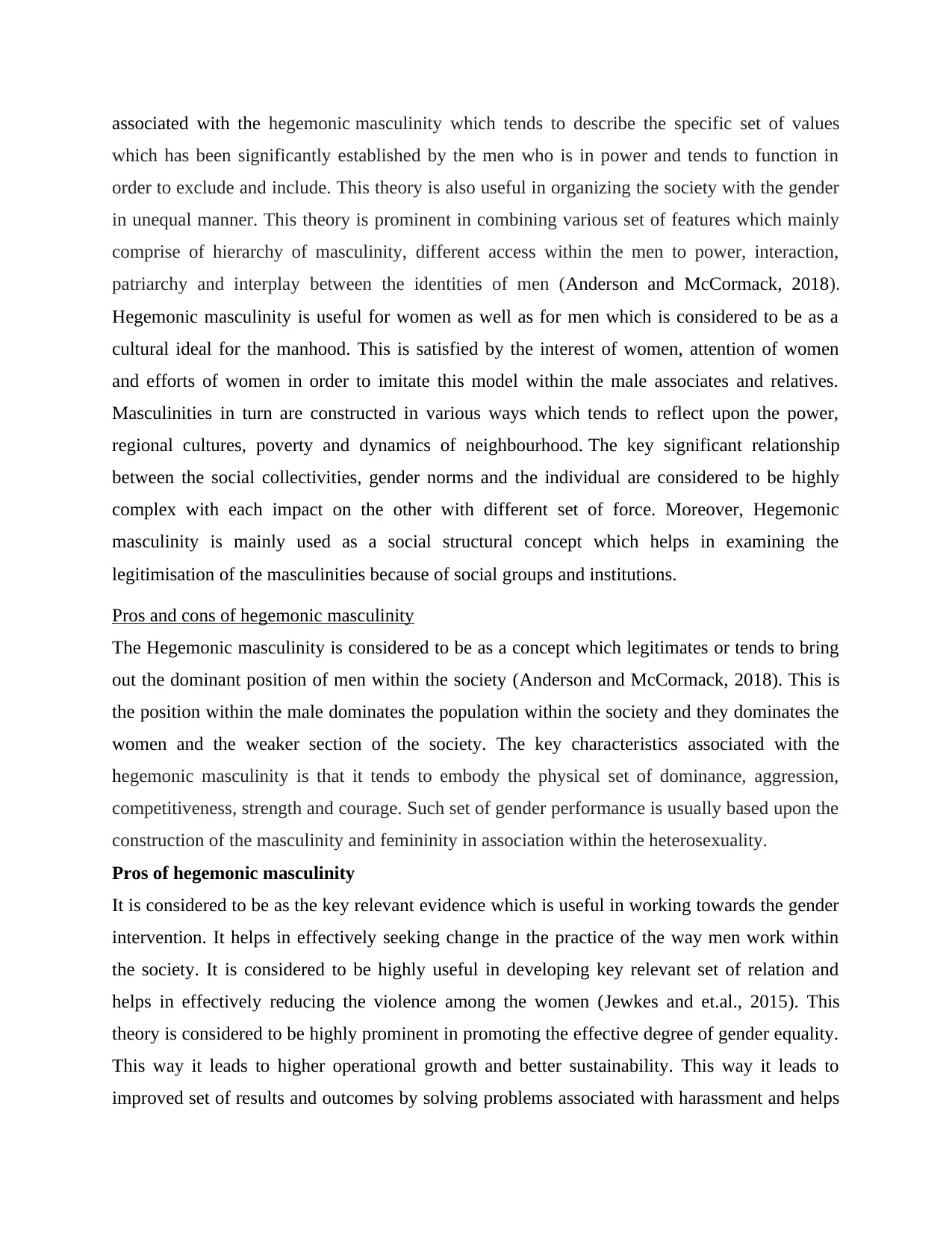
associated with the hegemonic masculinity which tends to describe the specific set of values
which has been significantly established by the men who is in power and tends to function in
order to exclude and include. This theory is also useful in organizing the society with the gender
in unequal manner. This theory is prominent in combining various set of features which mainly
comprise of hierarchy of masculinity, different access within the men to power, interaction,
patriarchy and interplay between the identities of men (Anderson and McCormack, 2018).
Hegemonic masculinity is useful for women as well as for men which is considered to be as a
cultural ideal for the manhood. This is satisfied by the interest of women, attention of women
and efforts of women in order to imitate this model within the male associates and relatives.
Masculinities in turn are constructed in various ways which tends to reflect upon the power,
regional cultures, poverty and dynamics of neighbourhood. The key significant relationship
between the social collectivities, gender norms and the individual are considered to be highly
complex with each impact on the other with different set of force. Moreover, Hegemonic
masculinity is mainly used as a social structural concept which helps in examining the
legitimisation of the masculinities because of social groups and institutions.
Pros and cons of hegemonic masculinity
The Hegemonic masculinity is considered to be as a concept which legitimates or tends to bring
out the dominant position of men within the society (Anderson and McCormack, 2018). This is
the position within the male dominates the population within the society and they dominates the
women and the weaker section of the society. The key characteristics associated with the
hegemonic masculinity is that it tends to embody the physical set of dominance, aggression,
competitiveness, strength and courage. Such set of gender performance is usually based upon the
construction of the masculinity and femininity in association within the heterosexuality.
Pros of hegemonic masculinity
It is considered to be as the key relevant evidence which is useful in working towards the gender
intervention. It helps in effectively seeking change in the practice of the way men work within
the society. It is considered to be highly useful in developing key relevant set of relation and
helps in effectively reducing the violence among the women (Jewkes and et.al., 2015). This
theory is considered to be highly prominent in promoting the effective degree of gender equality.
This way it leads to higher operational growth and better sustainability. This way it leads to
improved set of results and outcomes by solving problems associated with harassment and helps
which has been significantly established by the men who is in power and tends to function in
order to exclude and include. This theory is also useful in organizing the society with the gender
in unequal manner. This theory is prominent in combining various set of features which mainly
comprise of hierarchy of masculinity, different access within the men to power, interaction,
patriarchy and interplay between the identities of men (Anderson and McCormack, 2018).
Hegemonic masculinity is useful for women as well as for men which is considered to be as a
cultural ideal for the manhood. This is satisfied by the interest of women, attention of women
and efforts of women in order to imitate this model within the male associates and relatives.
Masculinities in turn are constructed in various ways which tends to reflect upon the power,
regional cultures, poverty and dynamics of neighbourhood. The key significant relationship
between the social collectivities, gender norms and the individual are considered to be highly
complex with each impact on the other with different set of force. Moreover, Hegemonic
masculinity is mainly used as a social structural concept which helps in examining the
legitimisation of the masculinities because of social groups and institutions.
Pros and cons of hegemonic masculinity
The Hegemonic masculinity is considered to be as a concept which legitimates or tends to bring
out the dominant position of men within the society (Anderson and McCormack, 2018). This is
the position within the male dominates the population within the society and they dominates the
women and the weaker section of the society. The key characteristics associated with the
hegemonic masculinity is that it tends to embody the physical set of dominance, aggression,
competitiveness, strength and courage. Such set of gender performance is usually based upon the
construction of the masculinity and femininity in association within the heterosexuality.
Pros of hegemonic masculinity
It is considered to be as the key relevant evidence which is useful in working towards the gender
intervention. It helps in effectively seeking change in the practice of the way men work within
the society. It is considered to be highly useful in developing key relevant set of relation and
helps in effectively reducing the violence among the women (Jewkes and et.al., 2015). This
theory is considered to be highly prominent in promoting the effective degree of gender equality.
This way it leads to higher operational growth and better sustainability. This way it leads to
improved set of results and outcomes by solving problems associated with harassment and helps
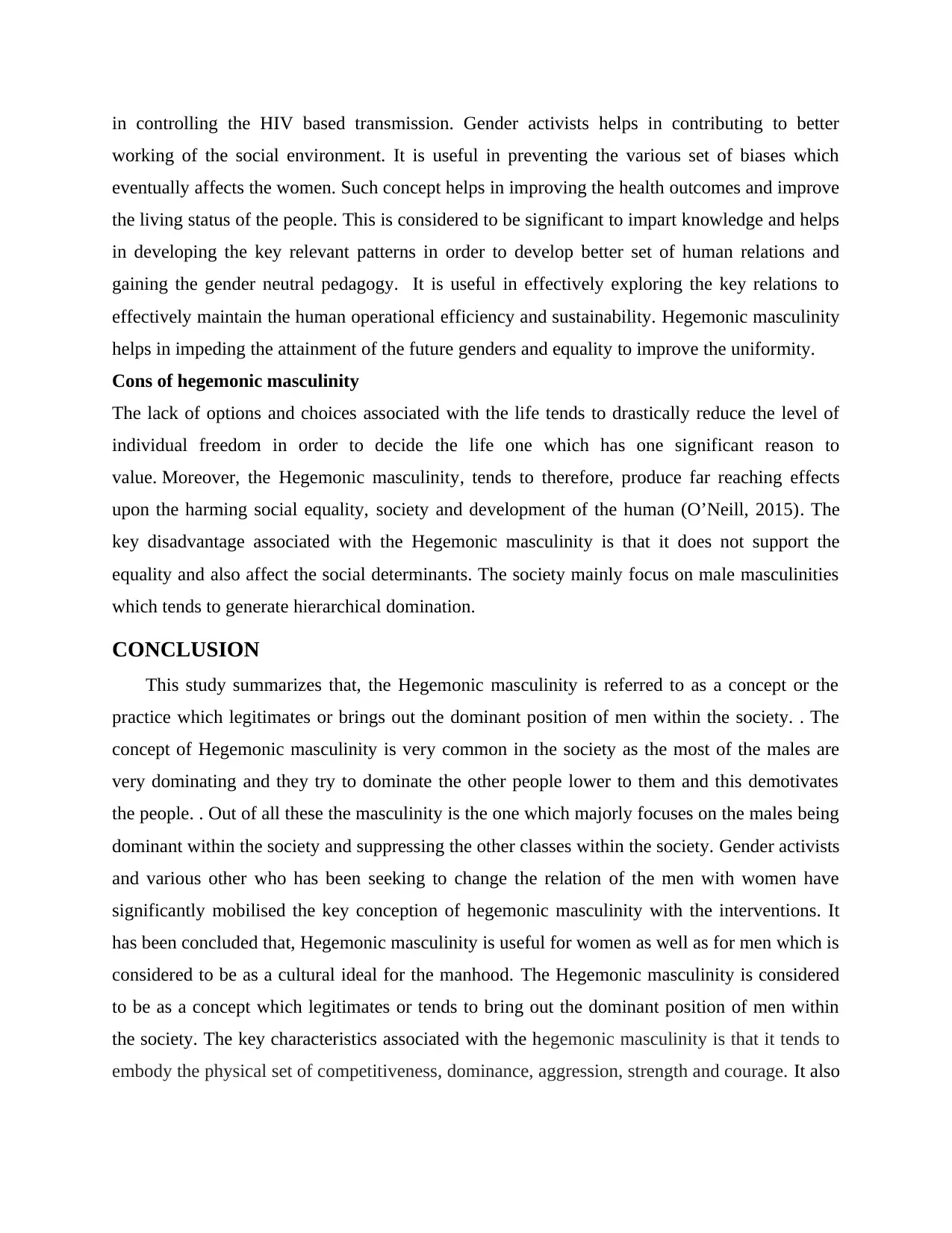
in controlling the HIV based transmission. Gender activists helps in contributing to better
working of the social environment. It is useful in preventing the various set of biases which
eventually affects the women. Such concept helps in improving the health outcomes and improve
the living status of the people. This is considered to be significant to impart knowledge and helps
in developing the key relevant patterns in order to develop better set of human relations and
gaining the gender neutral pedagogy. It is useful in effectively exploring the key relations to
effectively maintain the human operational efficiency and sustainability. Hegemonic masculinity
helps in impeding the attainment of the future genders and equality to improve the uniformity.
Cons of hegemonic masculinity
The lack of options and choices associated with the life tends to drastically reduce the level of
individual freedom in order to decide the life one which has one significant reason to
value. Moreover, the Hegemonic masculinity, tends to therefore, produce far reaching effects
upon the harming social equality, society and development of the human (O’Neill, 2015). The
key disadvantage associated with the Hegemonic masculinity is that it does not support the
equality and also affect the social determinants. The society mainly focus on male masculinities
which tends to generate hierarchical domination.
CONCLUSION
This study summarizes that, the Hegemonic masculinity is referred to as a concept or the
practice which legitimates or brings out the dominant position of men within the society. . The
concept of Hegemonic masculinity is very common in the society as the most of the males are
very dominating and they try to dominate the other people lower to them and this demotivates
the people. . Out of all these the masculinity is the one which majorly focuses on the males being
dominant within the society and suppressing the other classes within the society. Gender activists
and various other who has been seeking to change the relation of the men with women have
significantly mobilised the key conception of hegemonic masculinity with the interventions. It
has been concluded that, Hegemonic masculinity is useful for women as well as for men which is
considered to be as a cultural ideal for the manhood. The Hegemonic masculinity is considered
to be as a concept which legitimates or tends to bring out the dominant position of men within
the society. The key characteristics associated with the hegemonic masculinity is that it tends to
embody the physical set of competitiveness, dominance, aggression, strength and courage. It also
working of the social environment. It is useful in preventing the various set of biases which
eventually affects the women. Such concept helps in improving the health outcomes and improve
the living status of the people. This is considered to be significant to impart knowledge and helps
in developing the key relevant patterns in order to develop better set of human relations and
gaining the gender neutral pedagogy. It is useful in effectively exploring the key relations to
effectively maintain the human operational efficiency and sustainability. Hegemonic masculinity
helps in impeding the attainment of the future genders and equality to improve the uniformity.
Cons of hegemonic masculinity
The lack of options and choices associated with the life tends to drastically reduce the level of
individual freedom in order to decide the life one which has one significant reason to
value. Moreover, the Hegemonic masculinity, tends to therefore, produce far reaching effects
upon the harming social equality, society and development of the human (O’Neill, 2015). The
key disadvantage associated with the Hegemonic masculinity is that it does not support the
equality and also affect the social determinants. The society mainly focus on male masculinities
which tends to generate hierarchical domination.
CONCLUSION
This study summarizes that, the Hegemonic masculinity is referred to as a concept or the
practice which legitimates or brings out the dominant position of men within the society. . The
concept of Hegemonic masculinity is very common in the society as the most of the males are
very dominating and they try to dominate the other people lower to them and this demotivates
the people. . Out of all these the masculinity is the one which majorly focuses on the males being
dominant within the society and suppressing the other classes within the society. Gender activists
and various other who has been seeking to change the relation of the men with women have
significantly mobilised the key conception of hegemonic masculinity with the interventions. It
has been concluded that, Hegemonic masculinity is useful for women as well as for men which is
considered to be as a cultural ideal for the manhood. The Hegemonic masculinity is considered
to be as a concept which legitimates or tends to bring out the dominant position of men within
the society. The key characteristics associated with the hegemonic masculinity is that it tends to
embody the physical set of competitiveness, dominance, aggression, strength and courage. It also

produces far reaching effects upon the harming social equality, society and development of the
human.
human.
Secure Best Marks with AI Grader
Need help grading? Try our AI Grader for instant feedback on your assignments.
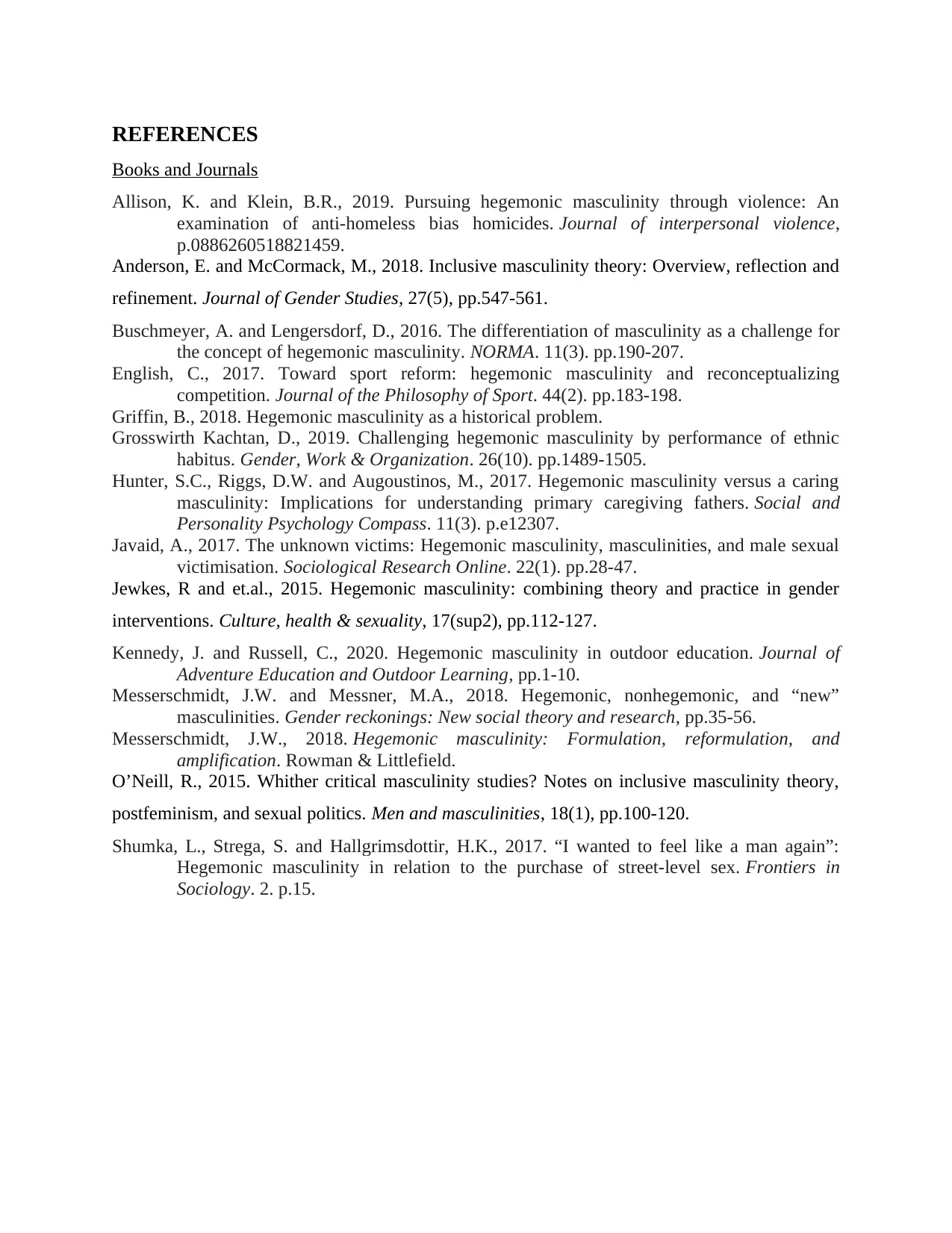
REFERENCES
Books and Journals
Allison, K. and Klein, B.R., 2019. Pursuing hegemonic masculinity through violence: An
examination of anti-homeless bias homicides. Journal of interpersonal violence,
p.0886260518821459.
Anderson, E. and McCormack, M., 2018. Inclusive masculinity theory: Overview, reflection and
refinement. Journal of Gender Studies, 27(5), pp.547-561.
Buschmeyer, A. and Lengersdorf, D., 2016. The differentiation of masculinity as a challenge for
the concept of hegemonic masculinity. NORMA. 11(3). pp.190-207.
English, C., 2017. Toward sport reform: hegemonic masculinity and reconceptualizing
competition. Journal of the Philosophy of Sport. 44(2). pp.183-198.
Griffin, B., 2018. Hegemonic masculinity as a historical problem.
Grosswirth Kachtan, D., 2019. Challenging hegemonic masculinity by performance of ethnic
habitus. Gender, Work & Organization. 26(10). pp.1489-1505.
Hunter, S.C., Riggs, D.W. and Augoustinos, M., 2017. Hegemonic masculinity versus a caring
masculinity: Implications for understanding primary caregiving fathers. Social and
Personality Psychology Compass. 11(3). p.e12307.
Javaid, A., 2017. The unknown victims: Hegemonic masculinity, masculinities, and male sexual
victimisation. Sociological Research Online. 22(1). pp.28-47.
Jewkes, R and et.al., 2015. Hegemonic masculinity: combining theory and practice in gender
interventions. Culture, health & sexuality, 17(sup2), pp.112-127.
Kennedy, J. and Russell, C., 2020. Hegemonic masculinity in outdoor education. Journal of
Adventure Education and Outdoor Learning, pp.1-10.
Messerschmidt, J.W. and Messner, M.A., 2018. Hegemonic, nonhegemonic, and “new”
masculinities. Gender reckonings: New social theory and research, pp.35-56.
Messerschmidt, J.W., 2018. Hegemonic masculinity: Formulation, reformulation, and
amplification. Rowman & Littlefield.
O’Neill, R., 2015. Whither critical masculinity studies? Notes on inclusive masculinity theory,
postfeminism, and sexual politics. Men and masculinities, 18(1), pp.100-120.
Shumka, L., Strega, S. and Hallgrimsdottir, H.K., 2017. “I wanted to feel like a man again”:
Hegemonic masculinity in relation to the purchase of street-level sex. Frontiers in
Sociology. 2. p.15.
Books and Journals
Allison, K. and Klein, B.R., 2019. Pursuing hegemonic masculinity through violence: An
examination of anti-homeless bias homicides. Journal of interpersonal violence,
p.0886260518821459.
Anderson, E. and McCormack, M., 2018. Inclusive masculinity theory: Overview, reflection and
refinement. Journal of Gender Studies, 27(5), pp.547-561.
Buschmeyer, A. and Lengersdorf, D., 2016. The differentiation of masculinity as a challenge for
the concept of hegemonic masculinity. NORMA. 11(3). pp.190-207.
English, C., 2017. Toward sport reform: hegemonic masculinity and reconceptualizing
competition. Journal of the Philosophy of Sport. 44(2). pp.183-198.
Griffin, B., 2018. Hegemonic masculinity as a historical problem.
Grosswirth Kachtan, D., 2019. Challenging hegemonic masculinity by performance of ethnic
habitus. Gender, Work & Organization. 26(10). pp.1489-1505.
Hunter, S.C., Riggs, D.W. and Augoustinos, M., 2017. Hegemonic masculinity versus a caring
masculinity: Implications for understanding primary caregiving fathers. Social and
Personality Psychology Compass. 11(3). p.e12307.
Javaid, A., 2017. The unknown victims: Hegemonic masculinity, masculinities, and male sexual
victimisation. Sociological Research Online. 22(1). pp.28-47.
Jewkes, R and et.al., 2015. Hegemonic masculinity: combining theory and practice in gender
interventions. Culture, health & sexuality, 17(sup2), pp.112-127.
Kennedy, J. and Russell, C., 2020. Hegemonic masculinity in outdoor education. Journal of
Adventure Education and Outdoor Learning, pp.1-10.
Messerschmidt, J.W. and Messner, M.A., 2018. Hegemonic, nonhegemonic, and “new”
masculinities. Gender reckonings: New social theory and research, pp.35-56.
Messerschmidt, J.W., 2018. Hegemonic masculinity: Formulation, reformulation, and
amplification. Rowman & Littlefield.
O’Neill, R., 2015. Whither critical masculinity studies? Notes on inclusive masculinity theory,
postfeminism, and sexual politics. Men and masculinities, 18(1), pp.100-120.
Shumka, L., Strega, S. and Hallgrimsdottir, H.K., 2017. “I wanted to feel like a man again”:
Hegemonic masculinity in relation to the purchase of street-level sex. Frontiers in
Sociology. 2. p.15.
1 out of 11
Related Documents
Your All-in-One AI-Powered Toolkit for Academic Success.
+13062052269
info@desklib.com
Available 24*7 on WhatsApp / Email
![[object Object]](/_next/static/media/star-bottom.7253800d.svg)
Unlock your academic potential
© 2024 | Zucol Services PVT LTD | All rights reserved.





